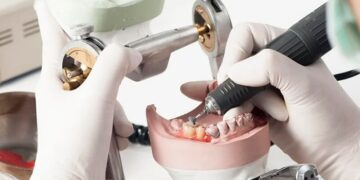Dental laboratories play a crucial role in the creation of dental appliances, such as dentures, crowns, and bridges. These appliances are essential for restoring the function and aesthetics of a patient’s smile, and their quality can greatly impact the overall success of a dental treatment. In this article, we will explore the various techniques used in dental laboratories to create perfect dental appliances, from traditional methods to modern technologies.
One of the key steps in creating dental appliances is the creation of a precise model of the patient’s mouth. This is typically done using impression materials, such as alginate or silicone, which are used to capture the shape and details of the patient’s teeth and gums. The impression is then used to create a plaster or stone model, which serves as a base for the creation of the dental appliance.
The Importance of Vacuum Forming in Dental Laboratories
In addition to traditional techniques, many dental laboratories use vacuum forming to create dental appliances. A vacuum former dental is a machine that uses heat and vacuum pressure to shape thermoplastic materials, such as acrylic or polyethylene, into precise forms. This technique is particularly useful for creating custom-fit appliances, such as mouthguards, orthodontic retainers, and denture bases. The vacuum former dental machine allows technicians to achieve a high level of accuracy and precision, ensuring a comfortable and secure fit for the patient. Furthermore, vacuum forming is a relatively quick and cost-effective process, making it an ideal solution for dental laboratories looking to increase efficiency and productivity.
Another important aspect of dental laboratory work is the selection of materials. With so many options available, technicians must carefully consider the properties and characteristics of each material to ensure that it meets the specific needs of the patient. For example, some materials may be more suitable for patients with sensitive teeth or gums, while others may be more durable and long-lasting.
In recent years, digital technologies have revolutionized the dental laboratory industry, enabling technicians to create dental appliances with greater precision and accuracy. Computer-aided design (CAD) software and 3D printing have become increasingly popular, allowing technicians to design and create complex appliances with ease. These technologies have also improved communication between dentists and dental laboratories, reducing errors and ensuring that appliances meet the required specifications.
In conclusion, creating perfect dental appliances requires a combination of traditional techniques, modern technologies, and attention to detail. By understanding the various techniques and materials used in dental laboratories, technicians can create high-quality appliances that meet the specific needs of each patient. Whether using traditional methods or modern technologies, the goal of every dental laboratory is to provide patients with comfortable, functional, and aesthetically pleasing dental appliances.
The Future of Dental Laboratories
As the dental laboratory industry continues to evolve, we can expect to see even more exciting developments in the years to come. One area of growth is in the field of digital dentistry, which involves the use of digital technologies to create dental appliances and restorations. This includes the use of CAD software, 3D printing, and digital impression systems. Another area of growth is in the field of biocompatible materials, which are designed to work in harmony with the body’s natural tissues. These materials have the potential to revolutionize the way we approach dental restorations and appliances, providing patients with more comfortable, durable, and long-lasting solutions.
























